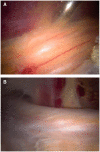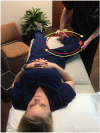Deep gluteal syndrome
- PMID: 27011826
- PMCID: PMC4718497
- DOI: 10.1093/jhps/hnv029
Deep gluteal syndrome
Abstract
Deep gluteal syndrome describes the presence of pain in the buttock caused from non-discogenic and extrapelvic entrapment of the sciatic nerve. Several structures can be involved in sciatic nerve entrapment within the gluteal space. A comprehensive history and physical examination can orientate the specific site where the sciatic nerve is entrapped, as well as several radiological signs that support the suspected diagnosis. Failure to identify the cause of pain in a timely manner can increase pain perception, and affect mental control, patient hope and consequently quality of life. This review presents a comprehensive approach to the patient with deep gluteal syndrome in order to improve the understanding of posterior hip anatomy, nerve kinematics, clinical manifestations, imaging findings, differential diagnosis and treatment considerations.
Figures











References
-
- McCrory P, Bell S. Nerve entrapment syndromes as a cause of pain in the hip, groin and buttock. Sports Med 1999; 27: 261–74. - PubMed
-
- Robinson DR. Pyriformis syndrome in relation to sciatic pain. Am J Surg 1947; 73: 355–8. - PubMed
-
- Filler AG, Haynes J, Jordan SE, et al. Sciatica of nondisc origin and piriformis syndrome: diagnosis by magnetic resonance neurography and interventional magnetic resonance imaging with outcome study of resulting treatment. J Neurosurg Spine 2005; 2: 99–115. - PubMed
-
- Martin HD, Shears SA, Johnson JC, et al. The endoscopic treatment of sciatic nerve entrapment/deep gluteal syndrome. Arthroscopy 2011; 27: 172–81. - PubMed
-
- Puranen J, Orava S. The hamstring syndrome: a new diagnosis of gluteal sciatic pain. Am J Sports Med 1988; 16: 517–21. - PubMed
LinkOut - more resources
Full Text Sources
Other Literature Sources
Medical

